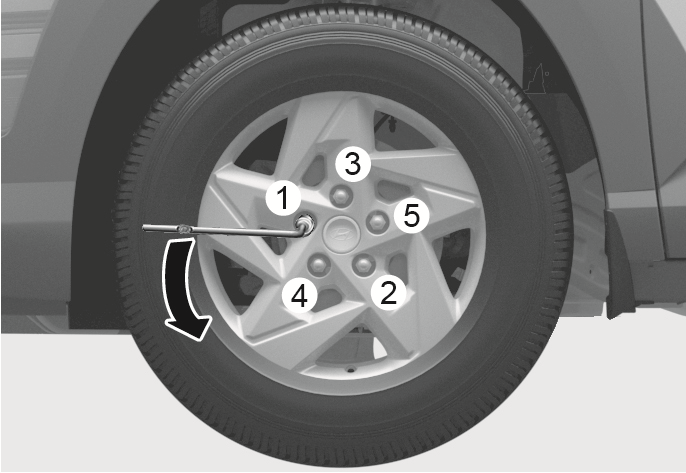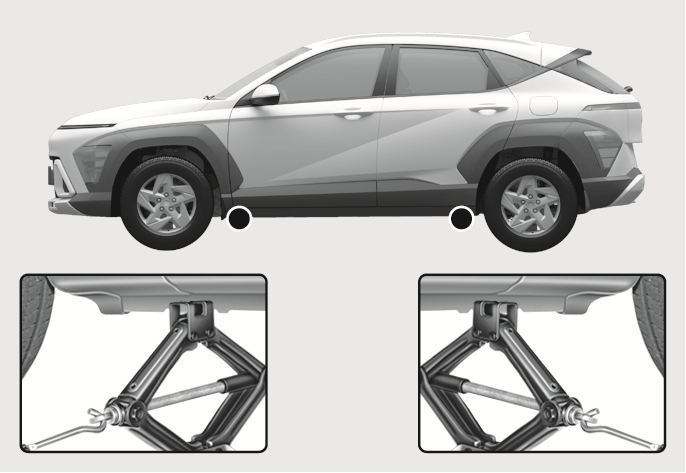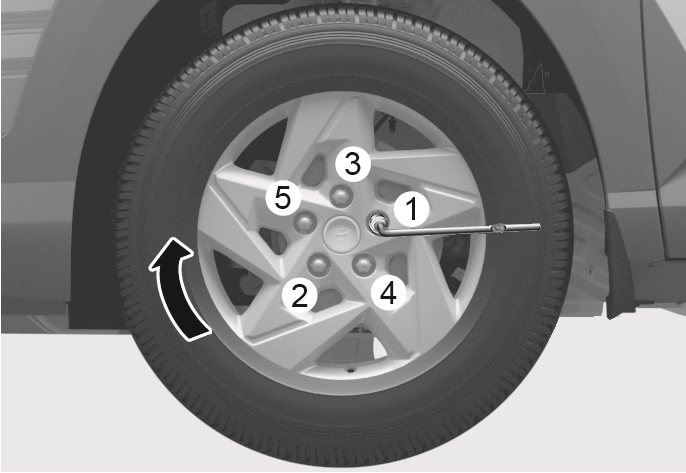Changing tyres
Because the vehicle may slip or roll off of a jack causing serious injury or death, take the following safety precautions:
-
NEVER place any portion of your body under a vehicle that is supported by a jack.
-
NEVER attempt to change a tyre in the lane of traffic. ALWAYS move the vehicle completely off the road on level, firm ground away from traffic before trying to change a tyre. If you cannot find a level, firm place off the road, call a towing service for assistance.
-
Be sure to use the jack provided with the vehicle.
-
ALWAYS place the jack on the designated jacking positions on the vehicle and NEVER on the bumpers or any other part of the vehicle for jacking support.
-
Do not start or run the engine whilst the vehicle is on the jack.
-
Do not allow anyone to remain in the vehicle whilst it is on the jack.
-
Keep children away from the road and the vehicle.
Follow these steps to change your vehicle’s tyre:
-
Park on a level, firm surface.
-
Shift the vehicle to P (Park), apply the parking brake, and press the Engine Start/Stop button to the OFF position.
-
Press the hazard warning flasher button.
-
Remove the wheel nut wrench, jack, jack handle and spare tyre from the vehicle.
-
Block both the front and rear of the tyre diagonally opposite of the tyre you are changing.

2C_SpareTireReplacementPrecedure_3
- Block
-
Loosen the wheel nuts anti-clockwise one turn each in the order shown above, but do not remove any wheel nuts until the tyre has been raised off of the ground.

2C_SpareTireReplacementPrecedure_4
-
Place the jack at the designated jacking position under the frame closest to the tyre you are changing. The jacking positions are plates welded to the frame with two notches. Never jack at any other position or part of the vehicle.

2C_SpareTireReplacementPrecedure_5
-
Insert the jack handle into the jack and turn it clockwise, raising the vehicle until the tyre clears the ground. Make sure the vehicle is stable on the jack.

2C_SpareTireReplacementPrecedure_6
-
Loosen the wheel nuts with the wheel nut wrench and remove them with your fingers. Remove the wheel from the studs and lay it flat on the ground out of the way. Remove any dirt or debris from the studs, mounting surfaces, and spare tyre.
Because the wheels may have sharp edges, handle them carefully to avoid possible severe injury. Before putting the wheel into place, make sure that there is nothing on the hub or wheel (such as mud, tar, gravel, etc.) that interferes with the wheel fitting solidly against the hub.
If there is, remove it. If there is not good contact on the mounting surface between the wheel and hub, the wheel nuts may come loose and cause the loss of a wheel. Loss of a wheel may result in loss of control of the vehicle. This may cause serious injury or death.
-
Install the spare tyre onto the studs of the hub.
-
Tighten the wheel nuts with your fingers onto the studs with the smaller end of the wheel nuts closest to the wheel.
-
Lower the vehicle to the ground by turning the jack handle anti-clockwise.
-
Use the wheel nut wrench to tighten the wheel nuts in the order shown. Double-check each wheel nut until they are tight. After changing tyres, we recommend that an authorised HYUNDAI dealer tighten the wheel nuts to their proper torque as soon as possible.
The wheel nut should be tightened to 11-13 kgf·m (79-94 lbf·ft).

2C_SpareTireReplacementPrecedure_7
Check the tyre pressure after installing the compact spare tyre. The compact spare tyre should be inflated to 60 psi (420 kPa).
If you have a tyre gauge, check the tyre pressure (refer to the “Tyres and wheels” section in chapter 2 for tyre pressure instructions). If the pressure is lower or higher than recommended, drive slowly to the nearest service station and adjust it to the recommended pressure.
Always reinstall the valve cap after checking or adjusting tyre pressure. If the cap is not replaced, air may leak from the tyre. If you lose a valve cap, buy another and install it as soon as possible. After changing tyres, secure the flat tyre and return the jack and tools to their proper storage locations.
Check the tyre pressure as soon as possible after installing a spare tyre. Adjust it to the recommended pressure.
-
Your vehicle has metric threads on the studs and wheel nuts. Make certain during tyre changing that the same bolts that were removed are reinstalled. If you have to replace your wheel nuts make sure they have metric threads to avoid damaging the studs and ensure the wheel is properly secured to the hub. We recommend that you consult an authorised HYUNDAI dealer for assistance.
-
If the wheel studs are damaged, they may lose their ability to retain the wheel. This may cause loss of the wheel and a collision resulting in serious injuries.
If any of the equipment such as the jack, wheel nuts, studs, or other equipment is damaged or in poor condition, do not attempt to change the tyre and call for assistance.
Compact spare tyres are designed for emergency use only. Drive carefully on the compact spare tyre and always follow the safety precautions.
To prevent compact spare tyre failure and loss of control possibly resulting in a collision:
-
Use the compact spare tyre only in an emergency.
-
Never operate your vehicle over 80 km/h.
-
Do not exceed the vehicle’s maximum load rating or the load carrying capacity shown on the sidewall of the compact spare tyre.
-
Do not use the compact spare tyre continuously. Repair or replace the original tyre as soon as possible to avoid failure of the compact spare tyre.
When driving with the compact spare tyre mounted to your vehicle:
-
Do not take this vehicle through an automatic car wash whilst the compact spare tyre is installed.
-
Do not use the compact spare tyre on any other vehicle because this tyre has been designed especially for your vehicle.
-
The compact spare tyre’s tread life is shorter than a regular tyre. Inspect your compact spare tyre regularly and replace worn compact spare tyres with the same size and design, mounted on the same wheel.
-
Do not use more than one compact spare tyre at a time.
-
Do not tow a trailer whilst the compact spare tyre is installed.
When the original tyre and wheel are repaired and reinstalled on the vehicle, the wheel nut torque must be set correctly. The correct wheel nut tightening torque is 11-13 kgf·m (79-94 lbf·ft).
To prevent damaging the compact spare tyre and your vehicle:
-
Drive slowly enough for the road conditions to avoid all hazards, such as a potholes or debris.
-
Avoid driving over obstacles. The compact spare tyre diameter is smaller than the diameter of a conventional tyre and reduces the ground clearance about 25 mm.
-
Do not use tyre chains on the compact spare tyre. Because of the smaller size, a tyre chain will not fit properly.
-
Do not use the compact spare tyre on any other wheels, nor should standard tyres, snow tyres, wheel covers or trim rings be used with the compact spare wheel.
-
Do not suddenly accelerate or decelerate (0-40 km/h) in any driving mode. It may cause leakage of transfer oil.